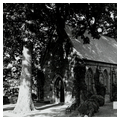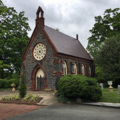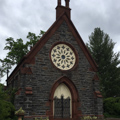Just inside the gates of Oak Hill Cemetery, on a ridge to the north, is a small elegant chapel by Renwick. Renwick's versatility with churches in the Gothic style is nowhere more evident than in a comparison between this modest commission and the imposing Grace Church of 1846–1847 or Saint Patrick's Cathedral of 1858–1879 in New York City. It was Renwick's work on the Smithsonian Institution (see ML05) that led him to this commission and to his later work on the first Corcoran Gallery of Art (see WH15) and Saint Mary's Episcopal Church (see FB16) in Foggy Bottom.
The diminutive chapel measures approximately 23 feet by 41 feet. Its one-story walls are formed of random courses of Potomac gneiss, a charcoal gray rock with high mica content. As trim, red sandstone is used at the water table, belt courses, window enframements, frieze, and finial. On the sides, four Gothic windows are separated by buttresses, each of which is capped with sandstone. Sandstone also appears at the front door frame, where moldings are anchored with sandstone








